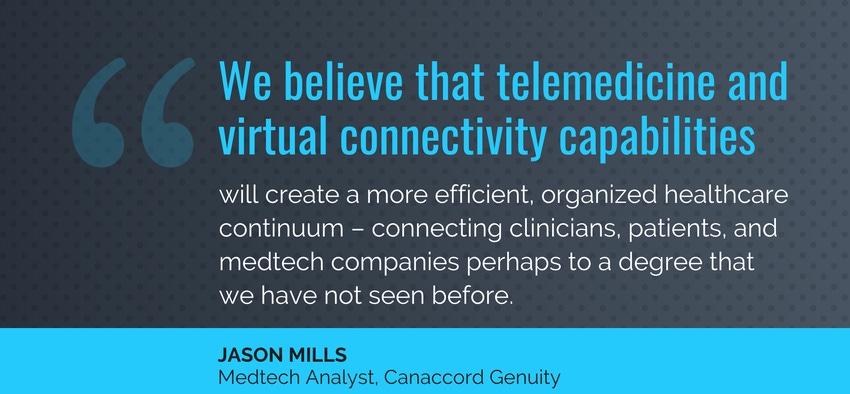Telemedicine Is Here to Stay
Some industry experts say that the rapid shift toward telemedicine in response to COVID-19 safety recommendations will stick long after the pandemic is over.
April 14, 2020

COVID-19 has prompted a rapid adoption of telemedicine, a trend that some experts say could have a significant and lasting impact on the medical device industry.
Jason Mills, a medtech analyst at Canaccord Genuity, shared conclusions earlier this week from three recent physician surveys that his firm conducted across the structural heart, robotic surgery, and stroke/venous thromboembolism fields. One of the key takeaways is that the overwhelming majority of doctors have "swiftly embraced" telemedicine during the crisis.
A look at some of the major telemedicine players' earnings projections for the year reaffirms the theory that these companies are coming out ahead right now.
Somerset, NJ-based MTBC recently reaffirmed its 2020 revenue and earnings guidance, which will represent year-over-year revenue and earnings growth (before interest, taxes, etc.) of 50% or more. MTBC provides cloud-based healthcare IT solutions and services, including telehealth. Bill Korn, MTBC's CFO, said that about 60% of the company's revenue is directly tied to the cash collected by its medical practice customers, which means the company's short-term revenue will decline as fewer patients visit their doctors during the COVID-19 pandemic. "However, a limited portion of this steep decline is expected to be offset by a significant increase in the percentage of patient encounters that are being managed through a variety of telehealth technologies," Korn said.
In a separate but related Canaccord Genuity report published April 13, Mills and his colleagues shared some interesting conclusions from a survey of medical device executives.
"The COVID-19 pandemic set off an accelerated shift to virtual communication in nearly every forum in which humans interact and, similarly, ... the medical device sector is also embracing the virtual world and will perhaps continue to do so long after the COVID crisis abates."
Medtech firms that emerge from the pandemic the strongest could be those that have embraced virtual connectivity, the cloud and data analytics to interact with and serve their customers, while also putting into action new best practices post-COVID, the Canaccord analysts note. They add that telemedicine and virtual connectivity will create a more efficient, organized healthcare continuum by connecting clinicians with both patients and medtech companies "perhaps to a degree that we have not seen before."
"Of the executives we surveyed, the majority spoke about how telemedicine 'is here now' and will remain dominant as we emerge from this crisis.
Tackling COVID-19, like any other crisis, requires effective communication and flow of both facts and ideas, realities and aspirations. From the confluence of myriad live conversations, discussions, and these survey responses, it became abundantly clear that the most radical change in the past month has been the shift of communication to digital platforms," Mills and colleagues noted. "... Our respondents believe that this zeitgeist is here to stay and may indeed transform communication between medical device companies and its myriad constituencies within the healthcare system."
That does, however, raise some other points of uncertainty, such as reimbursement and revenue generation. The Canaccord analysts said most medical device companies play within the fee-for-service reimbursement arena, so if patients are not being operated on, the ecosystem (payers, providers, and manufacturers) are not generating revenue.
"On the other hand, we believe an increase in utilization of telemedicine will serve to reduce some friction in the system, both near term and long term, thereby potentially enabling more expeditious patient referrals for imaging or diagnostic tests, thus leading perhaps to more, ubiquitous medical procedures, all things being equal of course on the supply side (capacity of ORs, adequate number of physicians to do the procedures, etc.)," the analysts said. "At the very least, we believe this could serve to keep the front end of the patient funnel percolating as the healthcare system migrates towards a more 'normal' time in the world, post-COVID. Either way, we think this telemedicine trend is a potentially under-appreciated driver of prospective patients."
While telemedicine can be seen as a rather broad terms, one specific area of this sector that is stepping into the spotlight is direct-to-consumer pharmacy and telemedicine companies, like New York, NY-based Conversion Labs, which can now offer patients immediate and virtual treatment from licensed physicians, along with home delivery of prescription medications bundled with over-the-counter wellness products.
"We see online diagnosis and treatment of patients and the associated pharmacy business as the next big wave that will fundamentally change the nation's $3.5 trillion healthcare market," said Justin Schreiber, president and CEO of Conversion Labs. "Driving this transformation will be the proven ability for telemedicine services and online pharmacies to improve access to healthcare while dramatically reducing costs for millions of Americans."
Schreiber said patients are turning to telemedicine (many for the first time) not only for the convenience factor but to avoid the elevated risk of being infected while at the doctor's office.
About the Author(s)
You May Also Like



.png?width=300&auto=webp&quality=80&disable=upscale)
